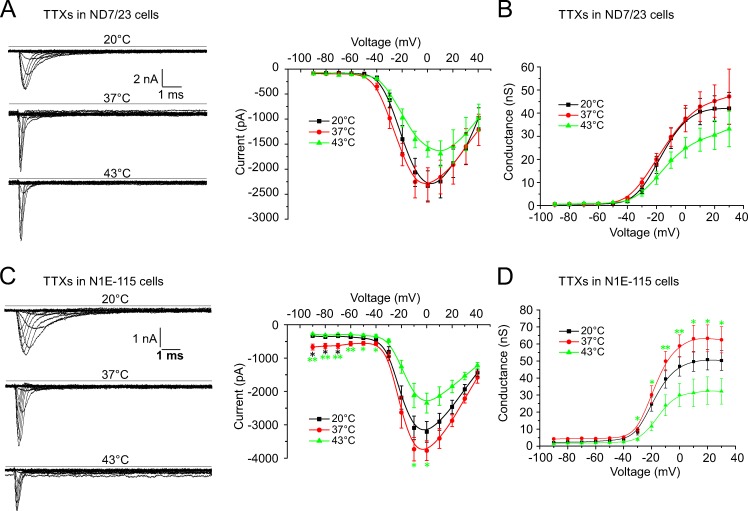Figure 3.
Warming reduces TTXs native sodium currents recorded from ND7/23 and N1E-115 cells. Cells were voltage-clamped at −90 mV and stimulated with 100-ms voltage pulses from −90 mV up to +40 mV using a CsF-based pipette solution. (A and C, left panels) Sample traces of the TTXs currents in ND7/23 (A) and N1E-115 (C) cells at three indicated temperatures. (A and C, right panels; and B and D) The effect of temperature on the voltage-dependence of activation and the conductance, respectively. (A and B) In ND7/23 cells, the TTXs peak current amplitude remained unchanged between 20°C and 37°C (−2,335.0 ± 302 pA, n = 20, to −2,314.1 ± 344 pA, n = 20) and decreased at 43°C (−1,605.4 ± 151 pA, n = 16). The effect of the temperature increase on the peak current conductance was similar (37.1 ± 5.1 nS at 20°C, n = 20; 37.6 ± 5.7 nS at 37°C, n = 17; and 25.0 ± 5.0 nS at 43°C, n = 16). (C and D) In N1E-115 cells, the TTXs peak current amplitude increased slightly between 20°C and 37°C (−3,210.0 ± 310.6 to −3,776.0 ± 294.8 pA) and decreased at 43°C (−2,350.0 ± 296.6 pA, n = 10, P = 0.047 between 37°C and 43°C). The effect of the temperature increase on the peak current conductance was similar (46.9 ± 5.7 nS at 20°C, n = 10; 58.9 ± 6.5 nS at 37°C, n = 10; and 30.1 ± 6.7 nS at 43°C, n = 9, P = 0.01 between 37°C and 43°C). Data are depicted as means ± SEM. *, P < 0.05; **, P < 0.01; and ***, P < 0.001 (one-way ANOVA with Tukey HSD).

